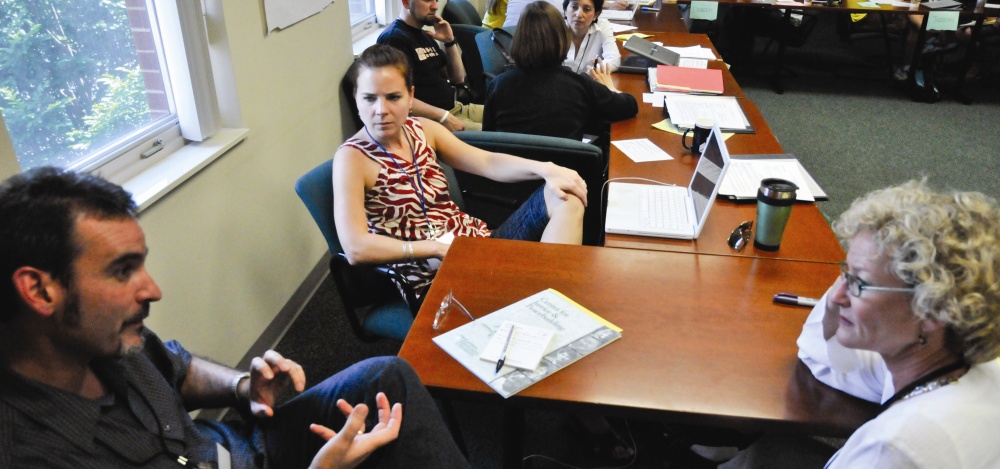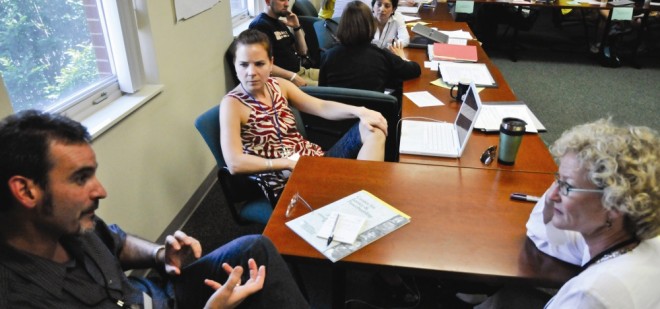
In the summer of 2010, a Massachusetts man who had just retired from 33 years of policing – the last 17 as a police chief – did an odd thing for relaxation and rejuvenation: he enrolled in Howard Zehr’s restorative justice class at EMU’s Summer Peacebuilding Institute (SPI).
Chief Len Wetherbee already knew quite a bit about the subject. While serving as chief in Concord, Massachusetts, he had read books by Howard Zehr and knew of Barry Stuart, a long-time judge in Canada who had written about the restorative ways indigenous peoples respond to “criminal” matters.
But now Wetherbee was interested in learning more about the university that had educated a bright, energetic woman he had helped recruit in 2008 to be executive director of Communities for Restorative Justice in Massachusetts.
Her name was Jennifer Larson Sawin (MA ’04) – she had previously worked with Central Virginia Restorative Justice in Charlottesville, Virginia, but landed in the Boston area when her physician-husband got a position with Tufts University.
“Chief Wetherbee called me throughout the week at SPI,” Larson Sawin recalls with a smile. “I suspected he’d be wary of the ritual components of SPI, but the coursework caught his imagination. He said the days went so quickly, five o’clock would roll around and he felt like the day had just started.”
At first, some of his SPI classmates were skeptical that police – often considered a fundamentally coercive force – could play a positive role in RJ processes. If only they had known the full scope of what was happening in Massachusetts.
Beginning in 2000, Wetherbee led his department to use restorative processes for juvenile offenses such as vandalism, trespassing, shoplifting, and bullying. The department encouraged the development of a group of trained volunteers to handle these matters, with an officer sitting in on each case.
The results were so positive, neighboring police departments got wind of the experiment and became interested too.
By the time Larson Sawin was hired in 2008, Communities for Restorative Justice had 80 trained volunteers handling referrals from police departments in two communities northwest of Boston.
Three years later, volunteers now number 100, and 10 communities are in the mix – including the urban communities of Cambridge and Arlington – with more communities knocking on the door. Offenses now include violent crime, offenders with records, and adult-initiated offenses.
“More of our police partners understand that restorative justice must treat the victim’s needs as central. If the victim wants restorative justice, it shouldn’t matter if the offender is 16 or 60, or that he broke into someone else’s house last week and therefore has a rap sheet,” explains Larson Sawin.
As an example of a successful case, Larson Sawin told of a swastika spray-painted on the side of a school building. The community wondered if there was a sleeper cell of neo-Nazis lurking about. When the young men responsible were caught, they agreed to participate in a circle process with members of the synagogue. They heard stories of childhood years spent in Nazi Germany and about all those who perished under that symbol. This encounter proved transformational for the young men.
As for the future, “we’ve got miles to go,” says Larson Sawin. “Any theory of change must include ‘bottom-up’ and ‘top-down’ strategies. While more communities are embracing this approach, we’re working towards statewide legislation. With folks like Chief Wetherbee in our corner, I know we’ll get there.”
